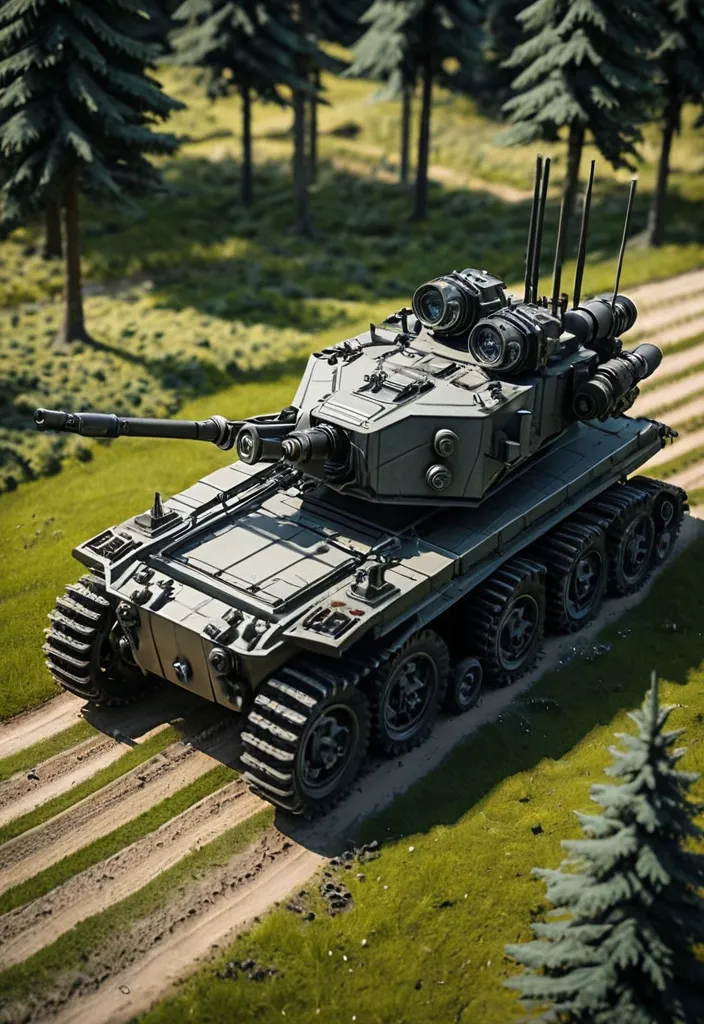AI Image Prompts for Mechanism
Explore AI generated designs, images, art and prompts by top community artists and designers.
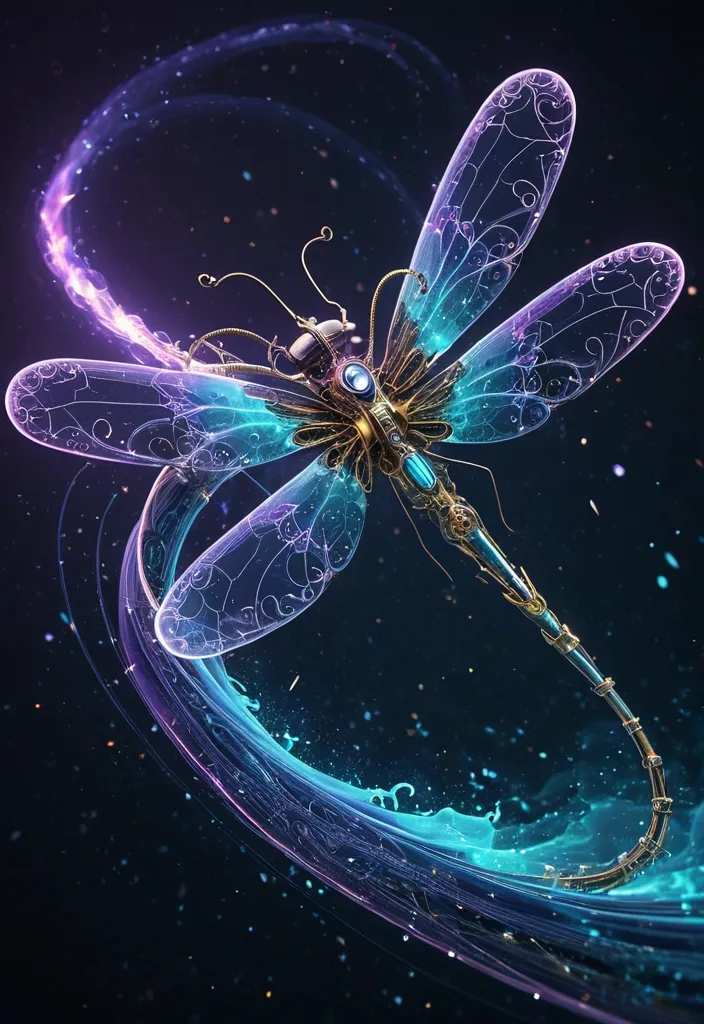
A flowing , Giant dragonfly , rendered in intricate clockwork and brass gears , swims through an abstract nebula of swirling digital data streams. The dragonfly bending into impossible angles , complex mechanism of interconnected parts , with glowing LED eyes peering out from the cosmic dust: electric blues , deep purples at the top and edge , shifting into bright cyan. The head tilts gently downward , defined only by subtle curves and shadows formed by the color transitions. perfect whale breaching a vast , calm ocean. Style: Celestial , ethereal , abstract , digital art smoking: Dramatic backlighting , bright glowing particles , contrasting dark background Composition: dynamic diagonal composition , upward gaze Details: Sparkling white waves and smoke , streaking white light trails , sense of movement and wonder , magical atmosphere Quality: High detail , 4K , Masterpiece , Rendered in Octane ,

A flowing , Giant spacecraft , rendered in intricate clockwork and brass gears , swims through an abstract nebula of swirling digital data streams. The spacecraft bending into impossible angles , complex mechanism of interconnected parts , with glowing LED eyes peering out from the cosmic dust: electric blues , deep purples at the top and edge , shifting into bright cyan. The head tilts gently downward , defined only by subtle curves and shadows formed by the color transitions. perfect whale breaching a vast , calm ocean. Style: Celestial , ethereal , abstract , digital art smoking: Dramatic backlighting , bright glowing particles , contrasting dark background Composition: dynamic diagonal composition , upward gaze Details: Sparkling white waves and smoke , streaking white light trails , sense of movement and wonder , magical atmosphere Quality: High detail , 4K , Masterpiece , Rendered in Octane ,

A flowing , Giant spacecraft , rendered in intricate clockwork and brass gears , swims through an abstract nebula of swirling digital data streams. The spacecraft bending into impossible angles , complex mechanism of interconnected parts , with glowing LED eyes peering out from the cosmic dust: electric blues , deep purples at the top and edge , shifting into bright cyan. The head tilts gently downward , defined only by subtle curves and shadows formed by the color transitions. perfect whale breaching a vast , calm ocean. Style: Celestial , ethereal , abstract , digital art smoking: Dramatic backlighting , bright glowing particles , contrasting dark background Composition: dynamic diagonal composition , upward gaze Details: Sparkling white waves and smoke , streaking white light trails , sense of movement and wonder , magical atmosphere Quality: High detail , 4K , Masterpiece , Rendered in Octane ,

A vast , multi-level fantasy clocktower interior repurposed as an adventurers’ headquarters. The space blends arcane laboratory , guild hall , and observatory. Architecture: black iron and brass , exposed gears , suspended bridges , glass floors revealing moving mechanisms below. Lighting: warm golden light from levitating crystal lamps and runic sconces. Soft daylight filters from tall stained-glass windows depicting celestial symbols and eight moons. Central feature: a large round table engraved with arcane runes — the Resonator Table , glowing faintly with three colored discs (red , blue , silver). Background details: parchment-cluttered desks , floating quills , a mechanical elevator cage , and Butler (a distinguished man in waistcoat) greeting adventurers. Upper balconies lined with books , hanging instruments , and a rotating crystal lens far above (the Eye of Hours). Mood: warm , industrious , mysterious; like a fusion of dwarven engineering and elven magic. Style: semi-realistic digital painting , cinematic lighting , richly detailed textures , slightly steampunk fantasy aesthetic. Camera: wide-angle interior shot from ground level looking up , emphasizing the tower’s height and golden glow. ,

A sorrowful woman , dressed in tattered , Victorian-era attire , sits amidst a dilapidated , steampunk workshop , surrounded by intricate clockwork mechanisms and discarded inventions , lit by soft gas lamps , casting long shadows , rendered in hyper-realistic pencil style , blending detail with soulful depth , reminiscent of Michael Garmash , Daniel F. Gerhartz , and Jeremy Mann. ,

A city built entirely of intricate clockwork mechanisms , gears turning and steam rising , under a perpetually twilight sky. Strange , mechanical birds with jewel-like eyes perch on towering spires. Style: Steampunk aesthetic with Mayan architectural influences , highly detailed , intricate , and atmospheric , with a touch of dark fantasy. ,

A futuristic cityscape built atop colossal gears and clockwork mechanisms , where flying vehicles weave through intricate networks of pipes and wires. The buildings are adorned with neon lights and holographic displays , with trains resembling colossal , chrome serpents gliding effortlessly through the sky. Passengers , a diverse array of travelers from across the galaxy. The scene is rendered in a detailed matte painting style , with deep colors , fantastical elements , and intricate details inspired by cyberpunk concept art. Reminiscent of a splash screen , with complementary colors and an 8k resolution trending on Artstation Unreal Engine 5. ,

The Megalosaurus Orca is a colossal marine hybrid dinosaur , measuring between 40 to 60 feet in length and weighing an astonishing 50 to 75 tons. Its body combines the robust , thick musculature and mighty jaw strength of Predator X and Megalodon with the sleek hydrodynamics and agility of the Mosasaurus Hoffmannii and transient killer whale. The creature’s skin is armored with large , overlapping bony scales inspired by the Arapaima , offering both flexibility and formidable protection against predators and environmental hazards. Its coloration is sexually dimorphic: males boast a deep black base coat adorned with light gray tiger stripes , while females display a gray base with stark white tiger stripes. Both sexes feature vivid red bioluminescent photophores arranged in tiger stripe patterns along their flanks and dorsal fins , used for communication , intimidation , mating displays , and luring prey in the abyssal darkness. The Megalosaurus Orca’s rigid pectoral fins can tilt back to reduce drag during high-speed pursuits , enabling bursts of speed up to 82 mph , rivaling the Black Marlin and shortfin mako shark. Powerful flippers , inspired by the leopard seal , allow it to scoot or slide short distances on land , useful for navigating beaches and shallow coasts. Its head features powerful jaws lined with dozens of large , long canine teeth capable of delivering over 40 , 000 PSI bite force , capable of crushing almost anything in its path. The skull is flexible , allowing it to swallow large prey whole. Crown-of-Thorns starfish-like venomous spines stud its dorsal ridge , serving as a defensive mechanism against attackers , and it can regenerate lost spines and limbs rapidly , a gift from its axolotl heritage. Abilities: Dual Respiratory System: Equipped with both functional lungs and gills , it can breathe underwater and survive brief excursions on land , as well as thrive at depths from 500 to 9 , 800 feet. Mucus Defense: Inspired by the Atlantic hagfish , it secretes a thick mucus layer that deters parasites and predators while retaining moisture during surface rests or land visits. Blubber Insulation: A thick layer of blubber provides thermal insulation , antimicrobial protection , and aids in rapid healing of wounds. The blubber’s varying stiffness across the body creates a springlike swimming motion , enhancing speed and agility. Stealth Hunting: Utilizing the transient killer whale’s passive listening abilities and silent movement , it stalks marine mammals and large prey with deadly precision , avoiding echolocation to remain undetected. Bioluminescent Communication: Red photophores allow complex signaling in the dark ocean depths for social interaction , mating , and intimidation. Salinity Tolerance: Can thrive in a wide range of salinity levels , from freshwater estuaries to the deep ocean , thanks to genetic traits from Mexican molly and saltwater crocodile. Reproductive Strategy: Live births occur in crushing-pressure depths up to 9 , 800 feet. Offspring are born adapted to extreme cold and pressure. The social group consists of a male and two females , balancing speed/power and endurance/nurturing roles. Behavior and Social Structure: Megalosaurus Orca travel in small , tight-knit family units of three , mirroring the transient killer whale’s social structure. The male leads high-speed hunts , using brute force and stealth , while females provide endurance and care for offspring. They communicate through low growls , barks , and the flashing of their bioluminescent stripes. Backstory: Created by the Ceno Evail Crossgen Corporation , the Megalosaurus Orca was engineered as the ultimate marine apex predator and survivor , blending the most fearsome traits of prehistoric and modern oceanic hunters. Designed to dominate both shallow and abyssal waters , it represents a pinnacle of genetic engineering with a lifespan reaching up to 135 years. Its creation was part of a secret project to explore deep-sea resource harvesting and marine ecosystem control , but its intelligence and adaptability have made it a subject of fascination and caution among researchers. ,

The Megalosaurus Orca is a colossal marine hybrid dinosaur , measuring between 40 to 60 feet in length and weighing an astonishing 50 to 75 tons. Its body combines the robust , thick musculature and mighty jaw strength of Predator X and Megalodon with the sleek hydrodynamics and agility of the Mosasaurus Hoffmannii and transient killer whale. The creature’s skin is armored with large , overlapping bony scales inspired by the Arapaima , offering both flexibility and formidable protection against predators and environmental hazards. Its coloration is sexually dimorphic: males boast a deep black base coat adorned with light gray tiger stripes , while females display a gray base with stark white tiger stripes. Both sexes feature vivid red bioluminescent photophores arranged in tiger stripe patterns along their flanks and dorsal fins , used for communication , intimidation , mating displays , and luring prey in the abyssal darkness. The Megalosaurus Orca’s rigid pectoral fins can tilt back to reduce drag during high-speed pursuits , enabling bursts of speed up to 82 mph , rivaling the Black Marlin and shortfin mako shark. Powerful flippers , inspired by the leopard seal , allow it to scoot or slide short distances on land , useful for navigating beaches and shallow coasts. Its head features powerful jaws lined with dozens of large , long canine teeth capable of delivering over 40 , 000 PSI bite force , capable of crushing almost anything in its path. The skull is flexible , allowing it to swallow large prey whole. Crown-of-Thorns starfish-like venomous spines stud its dorsal ridge , serving as a defensive mechanism against attackers , and it can regenerate lost spines and limbs rapidly , a gift from its axolotl heritage. Abilities: Dual Respiratory System: Equipped with both functional lungs and gills , it can breathe underwater and survive brief excursions on land , as well as thrive at depths from 500 to 9 , 800 feet. Mucus Defense: Inspired by the Atlantic hagfish , it secretes a thick mucus layer that deters parasites and predators while retaining moisture during surface rests or land visits. Blubber Insulation: A thick layer of blubber provides thermal insulation , antimicrobial protection , and aids in rapid healing of wounds. The blubber’s varying stiffness across the body creates a springlike swimming motion , enhancing speed and agility. Stealth Hunting: Utilizing the transient killer whale’s passive listening abilities and silent movement , it stalks marine mammals and large prey with deadly precision , avoiding echolocation to remain undetected. Bioluminescent Communication: Red photophores allow complex signaling in the dark ocean depths for social interaction , mating , and intimidation. Salinity Tolerance: Can thrive in a wide range of salinity levels , from freshwater estuaries to the deep ocean , thanks to genetic traits from Mexican molly and saltwater crocodile. Reproductive Strategy: Live births occur in crushing-pressure depths up to 9 , 800 feet. Offspring are born adapted to extreme cold and pressure. The social group consists of a male and two females , balancing speed/power and endurance/nurturing roles. Behavior and Social Structure: Megalosaurus Orca travel in small , tight-knit family units of three , mirroring the transient killer whale’s social structure. The male leads high-speed hunts , using brute force and stealth , while females provide endurance and care for offspring. They communicate through low growls , barks , and the flashing of their bioluminescent stripes. Backstory: Created by the Ceno Evail Crossgen Corporation , the Megalosaurus Orca was engineered as the ultimate marine apex predator and survivor , blending the most fearsome traits of prehistoric and modern oceanic hunters. Designed to dominate both shallow and abyssal waters , it represents a pinnacle of genetic engineering with a lifespan reaching up to 135 years. Its creation was part of a secret project to explore deep-sea resource harvesting and marine ecosystem control , but its intelligence and adaptability have made it a subject of fascination and caution among researchers. ,

A psychedelic , colorful landscape with a compact , modern electric sport-car with sleek , running on mountain road , streamlined contours designed for close and comfortable grooming , highlighted by sharp , detailed textures on its gray-metallic surfaces. The device rests on a reflective surface under bright , focused lighting that accentuates its precise craftsmanship and intricate blade mechanisms , conveying a sense of efficiency and high performance. vibrant colors , psychedelic swirls , a vibrant color palette , and bright colors in the style of digital art. ,

Meeting representatives of five different alien races gathered in a Futuristic architectural structure of a massive bio-mechanical Crab composed of rigid bones and metallic mechanisms , standing dominant in a desolate. plasma streaming up from the ground. Each race had its own unique features: one is covered in scales. the second has soft skin. the third looks like a living crystal , reflecting light. aliens close-up , the fourth is made of plasma , the fifth is made of ice ,
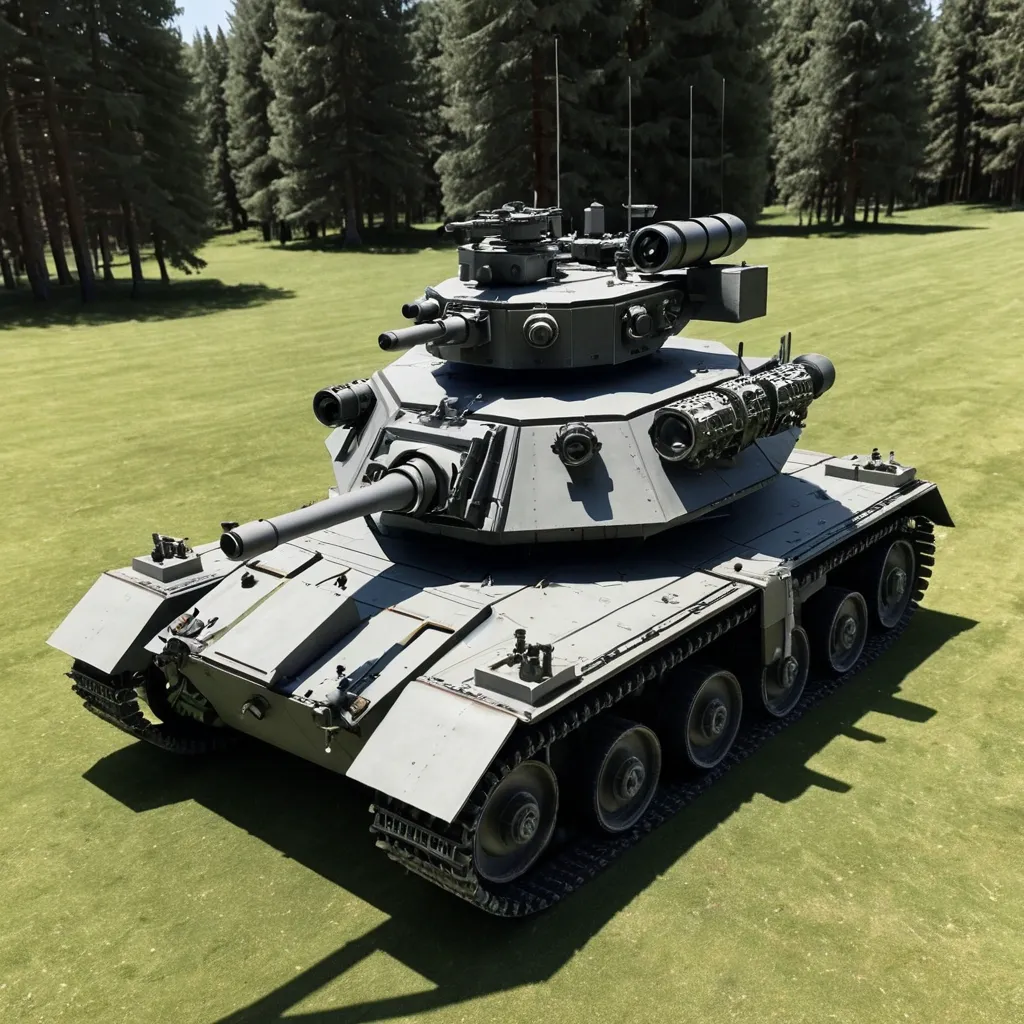
low six-wheeled platform with 3 wheels on each side , armored body , segmented into four parts. Four turrets in the form of machine guns , which have a belt with cartridges instead of a magazine. The first turret is directed forward to the right and up , the second turret is directed forward to the left and the horizon , the third turret is directed back slightly to the right and up , the fourth turret is directed back to the left and slightly up. Increased detail of the mechanisms Miniature video cameras with protective glazing are located on each turret There are guidance mechanisms Environment (forest-steppe) Multi-level grass Individual trees and small groves Compressed grass under equipment , natural shadows Technical details: Soft daylight Shadows from equipment Light glare on metal Perspective Top-down view at an angle Foreground detailing Additional elements Wheel tracks Small landscape details ,
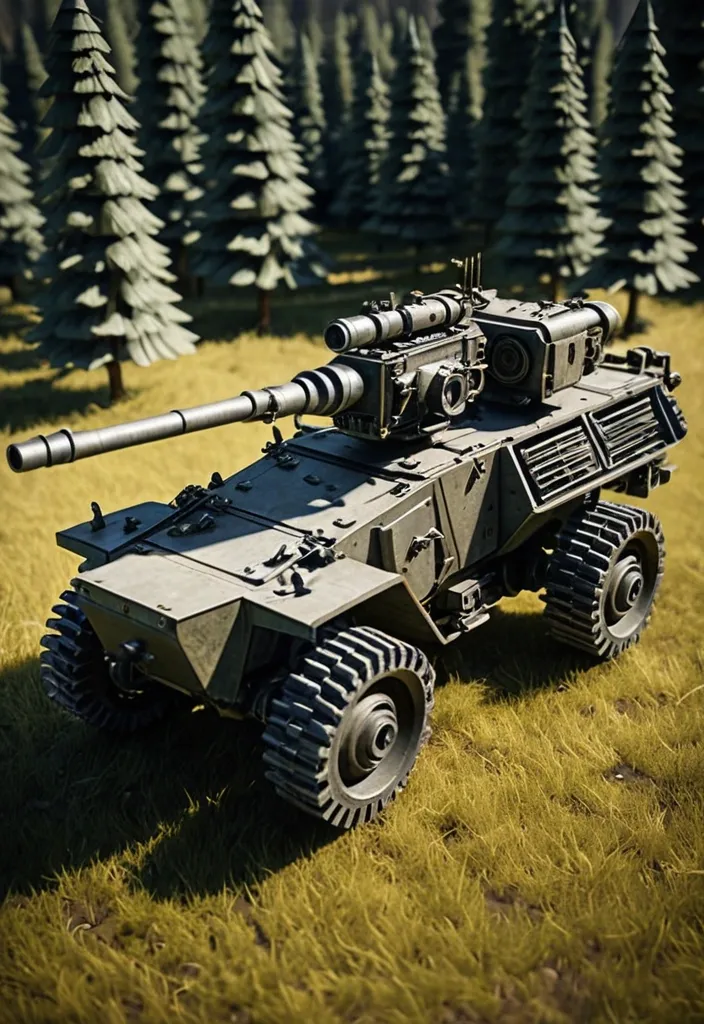
Six-wheeled platform with 3 wheels on each side , armored hullFour turrets in the form of belt machine guns , directed in different directionsRealistic armor textureDetailing of mechanismsMiniature video cameras with protective glass on each turretGuidance mechanismsEnvironment (forest-steppe)Grass of different levelsIndividual trees and small grovesCompressed grass under equipment , natural shadowsTechnical details:Soft daylightShadows from equipmentLight glare on metalPerspectiveTop-down view at an angleDetailing of the foregroundAdditional elementsTreads from wheelsSmall landscape details ,

Six-wheeled platform with 3 wheels on each side , armored hull Four turrets in the form of belt machine guns , directed in different directions Realistic armor texture Detailing of mechanisms Miniature video cameras with protective glass on each turret Guidance mechanisms Environment (forest-steppe) Grass of different levels Individual trees and small groves Compressed grass under equipment , natural shadows Technical details: Soft daylight Shadows from equipment Light glare on metal Perspective Top-down view at an angle Detailing of the foreground Additional elements Treads from wheels Small landscape details ,
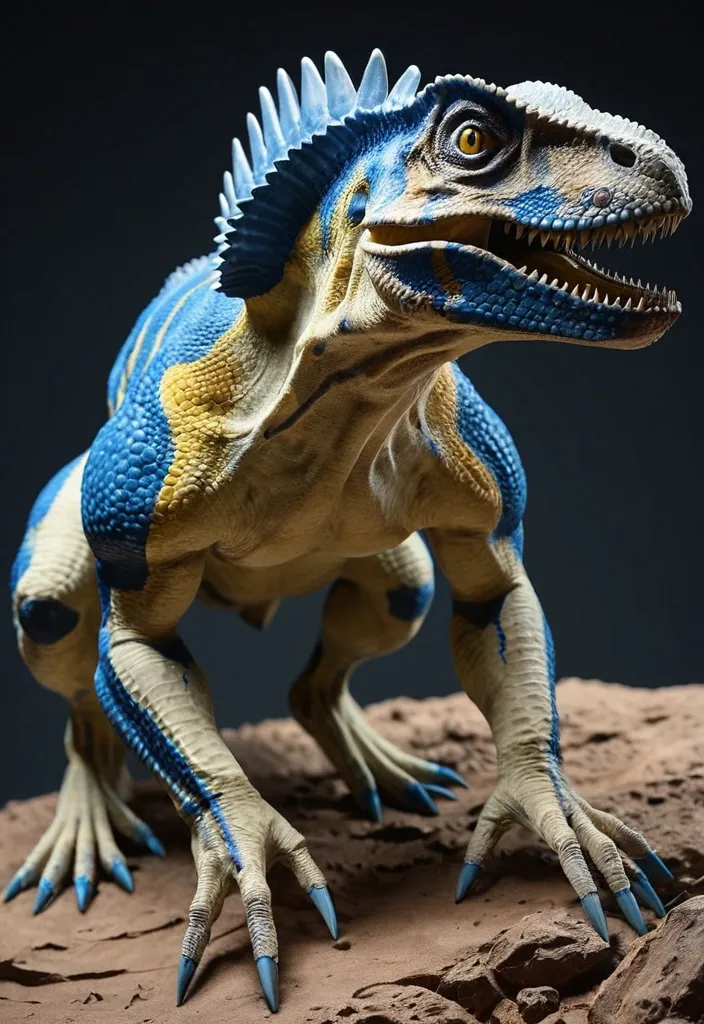
The hybrid was created by modifying the genome of a Tyrannosaurus rex , with the DNA of three other theropod species that were Utahraptor , Saurophaganax , and Giganotosaurus. Also the DNA of Quadrupes like Triceratops , and Scelidosaurus. DNA of modern animals such as Greater blue-ringed octopus , Inland Taipan , Northern Short-tailed Shrew , Komodo Dragon , Opossum , Mongoose , Gigantopithecus , Whiptail Lizard , Cuttlefish , and Tardigrades. The genome of Tyrannosaurus rex , Triceratops and Giganotosaurus was used as the base genome for the hybrid. Including the shape of the head in some parts from Giganotosaurus and Triceratops. Utahraptor DNA was added for high levels of intelligence and the ability to make plans , decisions and pack hunting. Reduced hind legs and Ape DNA added Knuckle-walking Quadruped. Triceratops , and Scelidosaurus were added to act as a biological form of armor that absorbed most of the incoming attacks. Northern short-tailed shrew , the Inland taipan's retractable fangs and the Komodo Dragon DNA was used to form the teeth of the Indominus that were used to tear through the flesh and armor of opponents. Saurophaganax and Gigantopithecus DNA added the presence of long strong arms with slashing hook claws and the use of tools. A swipe of the hybrid's claws would take down bigger opponents. While using tools for smaller elusive prey. Cuttlefish genes were intended to help the Venenosus withstand an accelerated growth , but it also added chromatophore cells in the skin so it could change the shape , color , and texture of its skin like a cuttlefish. Opossum , Mongoose and Tardigrades DNA was added for the Venenosus to be more resistant to climate changes , harmful toxins or bacterial infections , while tardigrades also added survival of extreme conditions such as exposure to extreme temperatures , extreme pressures , air deprivation , radiation , dehydration , and starvation. They have several defense mechanisms , including: A metabolic rate that gets as low as 0.01 percent of the normal rate. Organs protected by a sugary gel called trehalose. A protein that shields their DNA from radiation harm. Synthesis of cryoprotectant in chilly temperatures to prevent the development of ice crystals.Northern short-tailed shrew , the Inland Taipan , Greater blue-ringed octopus and the Komodo Dragon's DNA also added special cavities and glands in the skull that gave her infrared vision , and highly toxic saliva. Said DNA also gave her the ability to open her mandibles and jaws as wide as a snake , specifically at around 90 degrees.Lastly , DNA from a whiptail lizard was added for reproduction purposes. ,
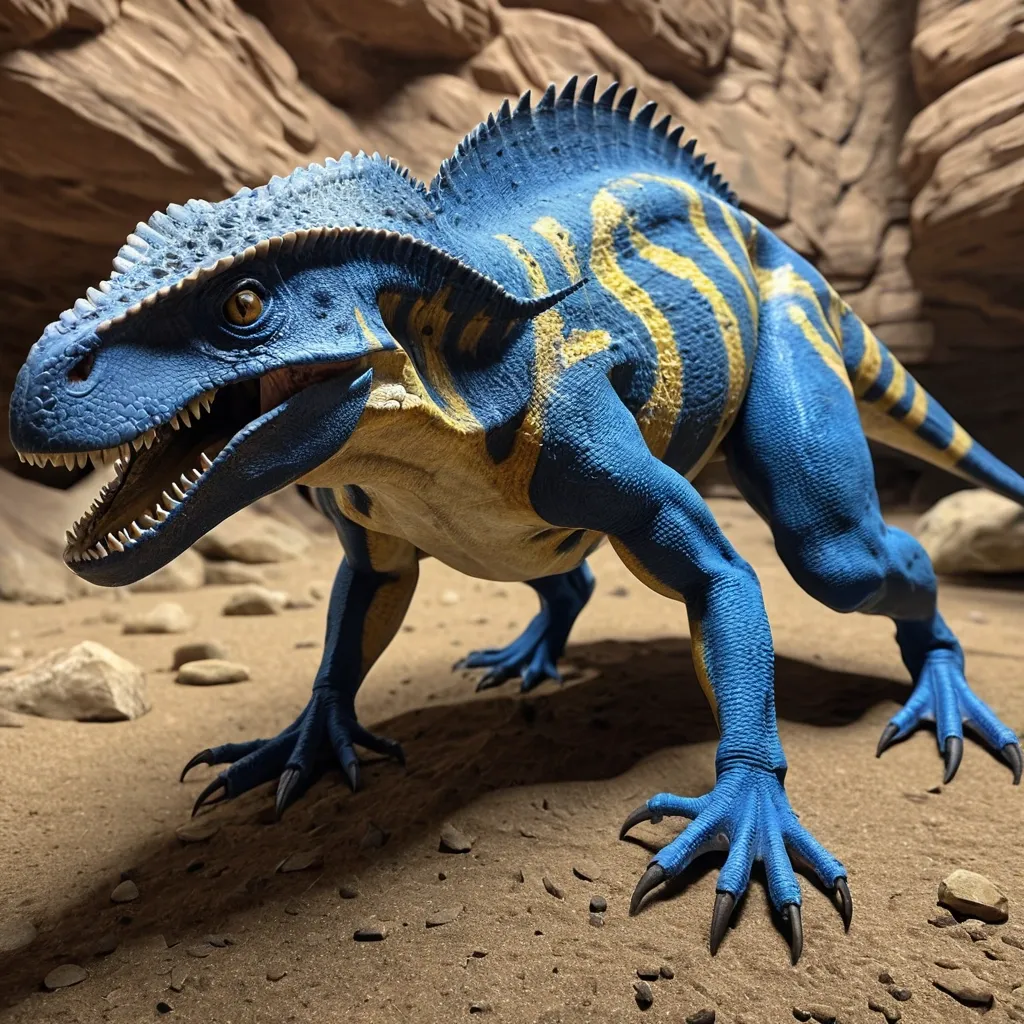
The hybrid was created by modifying the genome of a Tyrannosaurus rex , with the DNA of three other theropod species that were Utahraptor , Saurophaganax , and Giganotosaurus. Also the DNA of Quadrupes like Triceratops , and Scelidosaurus. DNA of modern animals such as Greater blue-ringed octopus , Inland Taipan , Northern Short-tailed Shrew , Komodo Dragon , Opossum , Mongoose , Gigantopithecus , Whiptail Lizard , Cuttlefish , and Tardigrades. The genome of Tyrannosaurus rex , Triceratops and Giganotosaurus was used as the base genome for the hybrid. Including the shape of the head in some parts from Giganotosaurus and Triceratops. Utahraptor DNA was added for high levels of intelligence and the ability to make plans , decisions and pack hunting. Reduced hind legs and Ape DNA added Knuckle-walking Quadruped. Triceratops , and Scelidosaurus were added to act as a biological form of armor that absorbed most of the incoming attacks. Northern short-tailed shrew , the Inland taipan's retractable fangs and the Komodo Dragon DNA was used to form the teeth of the Indominus that were used to tear through the flesh and armor of opponents. Saurophaganax and Gigantopithecus DNA added the presence of long strong arms with slashing hook claws and the use of tools. A swipe of the hybrid's claws would take down bigger opponents. While using tools for smaller elusive prey. Cuttlefish genes were intended to help the Venenosus withstand an accelerated growth , but it also added chromatophore cells in the skin so it could change the shape , color , and texture of its skin like a cuttlefish. Opossum , Mongoose and Tardigrades DNA was added for the Venenosus to be more resistant to climate changes , harmful toxins or bacterial infections , while tardigrades also added survival of extreme conditions such as exposure to extreme temperatures , extreme pressures , air deprivation , radiation , dehydration , and starvation. They have several defense mechanisms , including: A metabolic rate that gets as low as 0.01 percent of the normal rate. Organs protected by a sugary gel called trehalose. A protein that shields their DNA from radiation harm. Synthesis of cryoprotectant in chilly temperatures to prevent the development of ice crystals.Northern short-tailed shrew , the Inland Taipan , Greater blue-ringed octopus and the Komodo Dragon's DNA also added special cavities and glands in the skull that gave her infrared vision , and highly toxic saliva. Said DNA also gave her the ability to open her mandibles and jaws as wide as a snake , specifically at around 90 degrees.Lastly , DNA from a whiptail lizard was added for reproduction purposes. ,
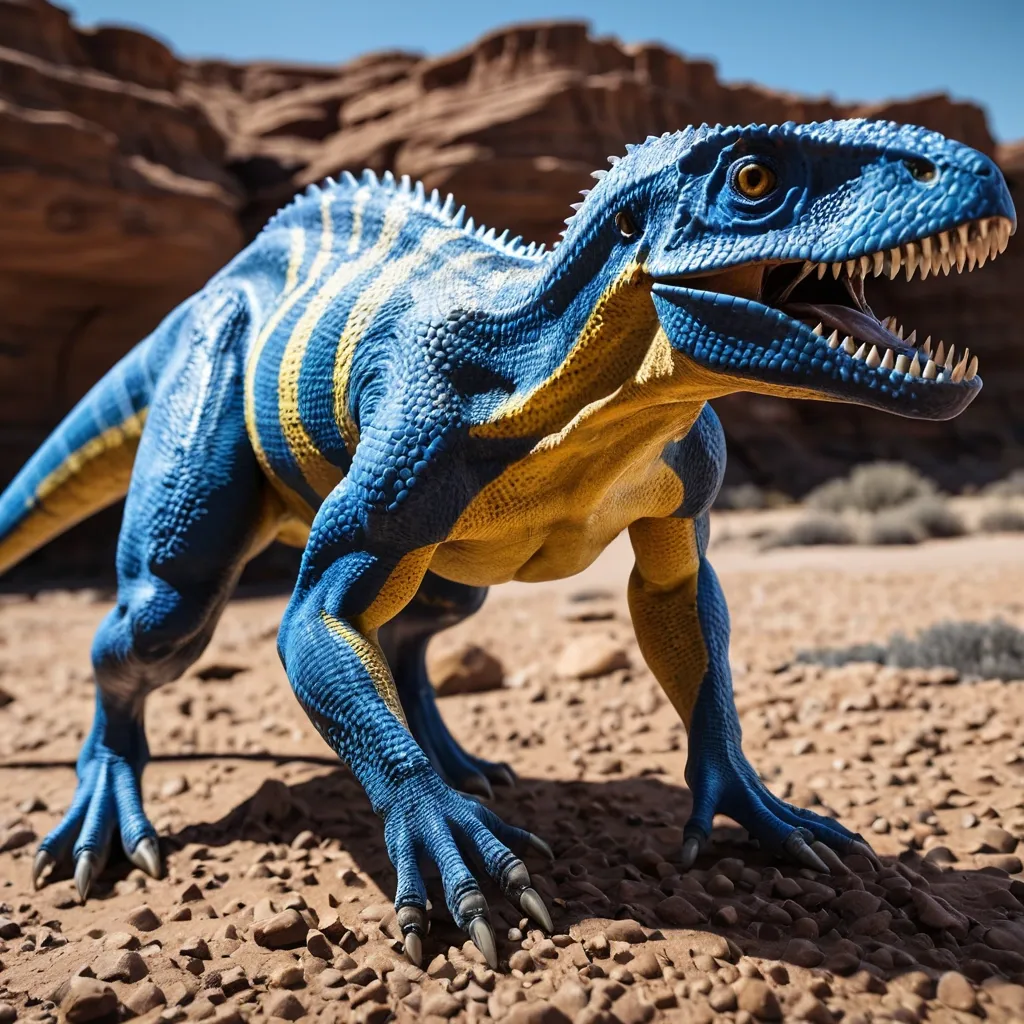
The hybrid was created by modifying the genome of a Tyrannosaurus rex , with the DNA of three other theropod species that were Utahraptor , Saurophaganax , and Giganotosaurus. Also the DNA of Quadrupes like Triceratops , and Scelidosaurus. DNA of modern animals such as Greater blue-ringed octopus , Inland Taipan , Northern Short-tailed Shrew , Komodo Dragon , Opossum , Mongoose , Gigantopithecus , Whiptail Lizard , Cuttlefish , and Tardigrades. The genome of Tyrannosaurus rex , Triceratops and Giganotosaurus was used as the base genome for the hybrid. Including the shape of the head in some parts from Giganotosaurus and Triceratops. Utahraptor DNA was added for high levels of intelligence and the ability to make plans , decisions and pack hunting. Reduced hind legs and Ape DNA added Knuckle-walking Quadruped. Triceratops , and Scelidosaurus were added to act as a biological form of armor that absorbed most of the incoming attacks. Northern short-tailed shrew , the Inland taipan's retractable fangs and the Komodo Dragon DNA was used to form the teeth of the Indominus that were used to tear through the flesh and armor of opponents. Saurophaganax and Gigantopithecus DNA added the presence of long strong arms with slashing hook claws and the use of tools. A swipe of the hybrid's claws would take down bigger opponents. While using tools for smaller elusive prey. Cuttlefish genes were intended to help the Venenosus withstand an accelerated growth , but it also added chromatophore cells in the skin so it could change the shape , color , and texture of its skin like a cuttlefish. Opossum , Mongoose and Tardigrades DNA was added for the Venenosus to be more resistant to climate changes , harmful toxins or bacterial infections , while tardigrades also added survival of extreme conditions such as exposure to extreme temperatures , extreme pressures , air deprivation , radiation , dehydration , and starvation. They have several defense mechanisms , including: A metabolic rate that gets as low as 0.01 percent of the normal rate. Organs protected by a sugary gel called trehalose. A protein that shields their DNA from radiation harm. Synthesis of cryoprotectant in chilly temperatures to prevent the development of ice crystals.Northern short-tailed shrew , the Inland Taipan , Greater blue-ringed octopus and the Komodo Dragon's DNA also added special cavities and glands in the skull that gave her infrared vision , and highly toxic saliva. Said DNA also gave her the ability to open her mandibles and jaws as wide as a snake , specifically at around 90 degrees.Lastly , DNA from a whiptail lizard was added for reproduction purposes. ,
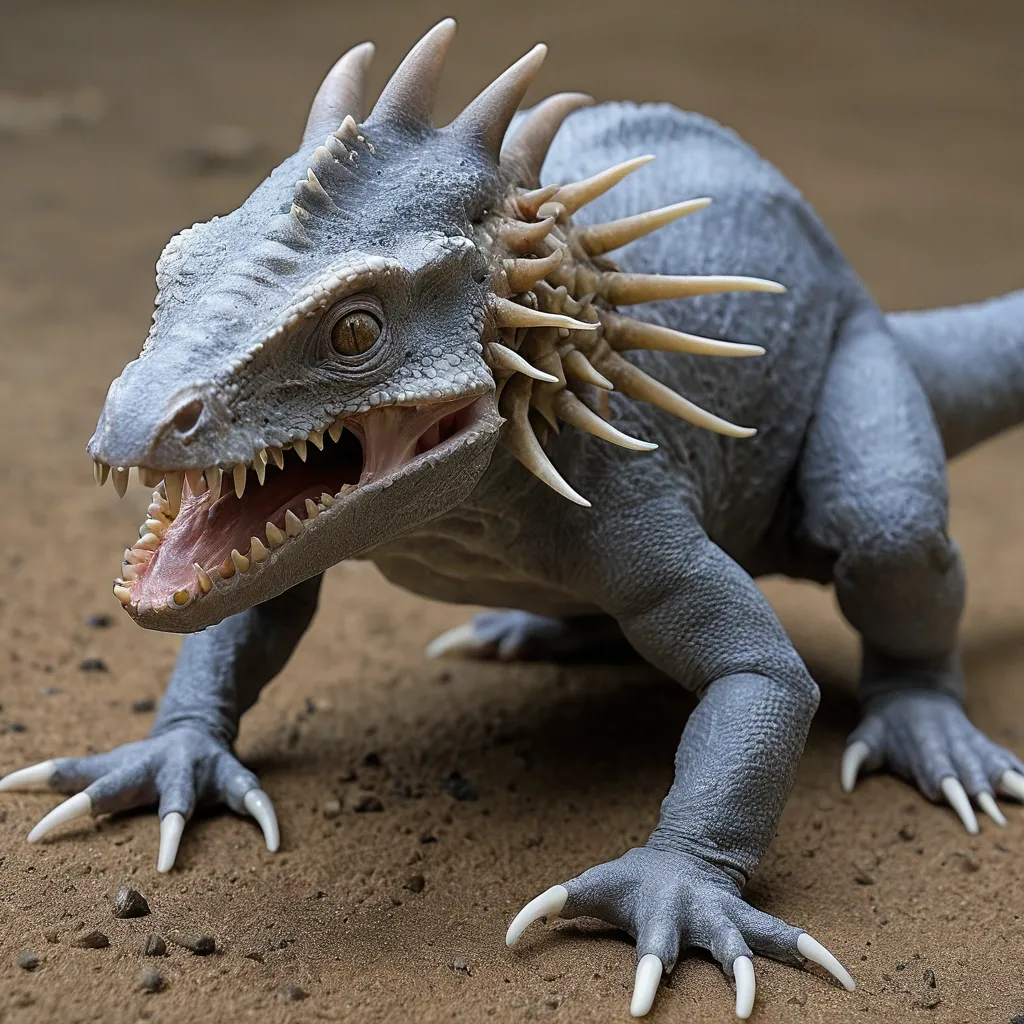
The genome of Tyrannosaurus rex , Triceratops and Giganotosaurus was used as the base genome for the hybrid. Including the shape of the head in some parts from Triceratops. Utahraptor DNA was added for high levels of intelligence and the ability to make plans , decisions and pack hunting. Reduced hind legs and Ape DNA added Knuckle-walking Quadruped. Triceratops , and Scelidosaurus were added to act as a biological form of armor that absorbed most of the incoming attacks. Northern short-tailed shrew , the Inland taipan's retractable fangs and the Komodo Dragon DNA was used to form the teeth of the Indominus that were used to tear through the flesh and armor of opponents. Saurophaganax and Gigantopithecus DNA added the presence of long strong arms with slashing hook claws and the use of tools. A swipe of the hybrid's claws would take down bigger opponents. While using tools for smaller elusive prey. Cuttlefish genes were intended to help the Venenosus withstand an accelerated growth , but it also added chromatophore cells in the skin so it could change the shape , color , and texture of its skin like a cuttlefish. Opossum , Mongoose and Tardigrades DNA was added for the Venenosus to be more resistant to climate changes , harmful toxins or bacterial infections , while tardigrades also added survival of extreme conditions such as exposure to extreme temperatures , extreme pressures , air deprivation , radiation , dehydration , and starvation. They have several defense mechanisms , including: A metabolic rate that gets as low as 0.01 percent of the normal rate. Organs protected by a sugary gel called trehalose. A protein that shields their DNA from radiation harm. Synthesis of cryoprotectant in chilly temperatures to prevent the development of ice crystals.Northern short-tailed shrew , the Inland Taipan , Greater blue-ringed octopus and the Komodo Dragon's DNA also added special cavities and glands in the skull that gave her infrared vision , and highly toxic saliva. Said DNA also gave her the ability to open her mandibles and jaws as wide as a snake , specifically at around 90 degrees.Lastly , DNA from a whiptail lizard was added for reproduction purposes. ,
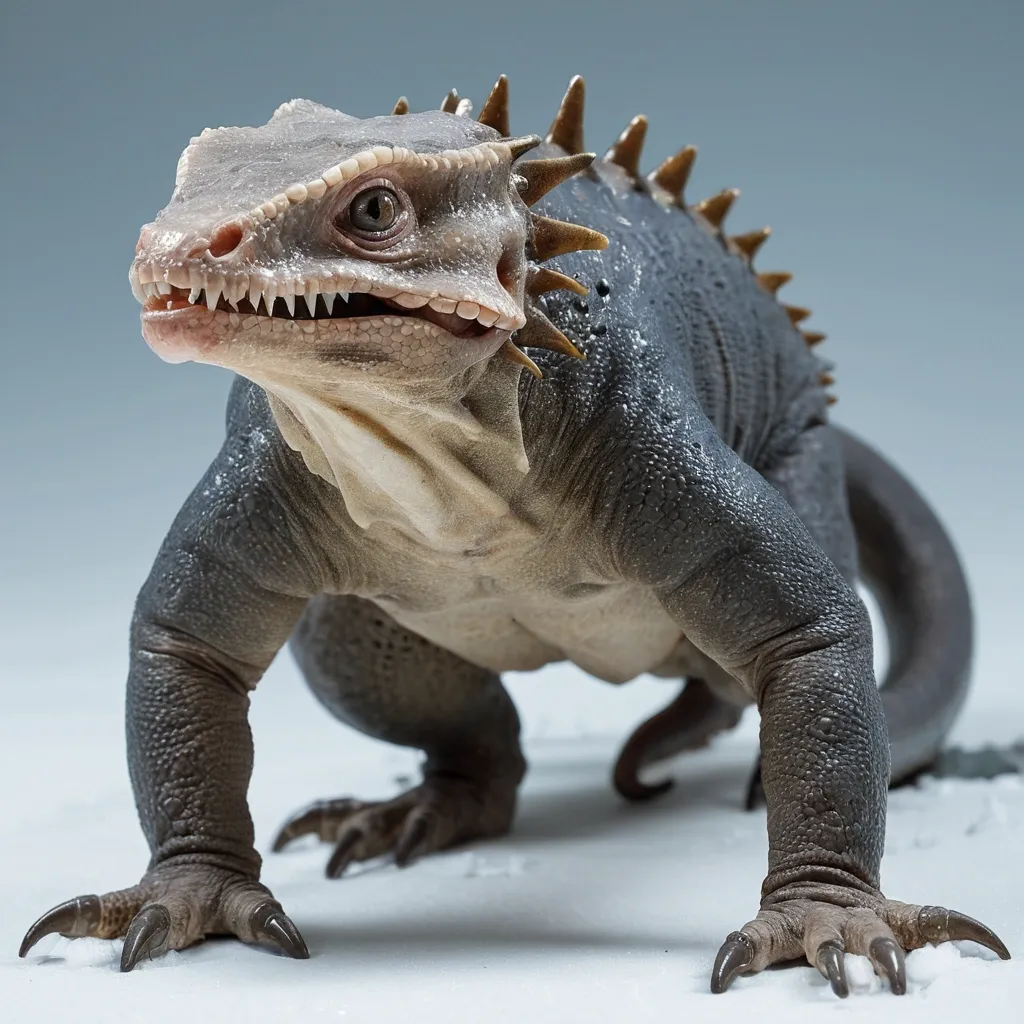
The genome of Tyrannosaurus rex , Triceratops and Giganotosaurus was used as the base genome for the hybrid. Including the shape of the head in some parts from Triceratops. Utahraptor DNA was added for high levels of intelligence and the ability to make plans , decisions and pack hunting. Reduced hind legs and Ape DNA added Knuckle-walking Quadruped. Triceratops , and Scelidosaurus were added to act as a biological form of armor that absorbed most of the incoming attacks. Northern short-tailed shrew , the Inland taipan's retractable fangs and the Komodo Dragon DNA was used to form the teeth of the Indominus that were used to tear through the flesh and armor of opponents. Saurophaganax and Gigantopithecus DNA added the presence of long strong arms with slashing hook claws and the use of tools. A swipe of the hybrid's claws would take down bigger opponents. While using tools for smaller elusive prey. Cuttlefish genes were intended to help the Venenosus withstand an accelerated growth , but it also added chromatophore cells in the skin so it could change the shape , color , and texture of its skin like a cuttlefish. Opossum , Mongoose and Tardigrades DNA was added for the Venenosus to be more resistant to climate changes , harmful toxins or bacterial infections , while tardigrades also added survival of extreme conditions such as exposure to extreme temperatures , extreme pressures , air deprivation , radiation , dehydration , and starvation. They have several defense mechanisms , including: A metabolic rate that gets as low as 0.01 percent of the normal rate. Organs protected by a sugary gel called trehalose. A protein that shields their DNA from radiation harm. Synthesis of cryoprotectant in chilly temperatures to prevent the development of ice crystals.Northern short-tailed shrew , the Inland Taipan , Greater blue-ringed octopus and the Komodo Dragon's DNA also added special cavities and glands in the skull that gave her infrared vision , and highly toxic saliva. Said DNA also gave her the ability to open her mandibles and jaws as wide as a snake , specifically at around 90 degrees.Lastly , DNA from a whiptail lizard was added for reproduction purposes. ,
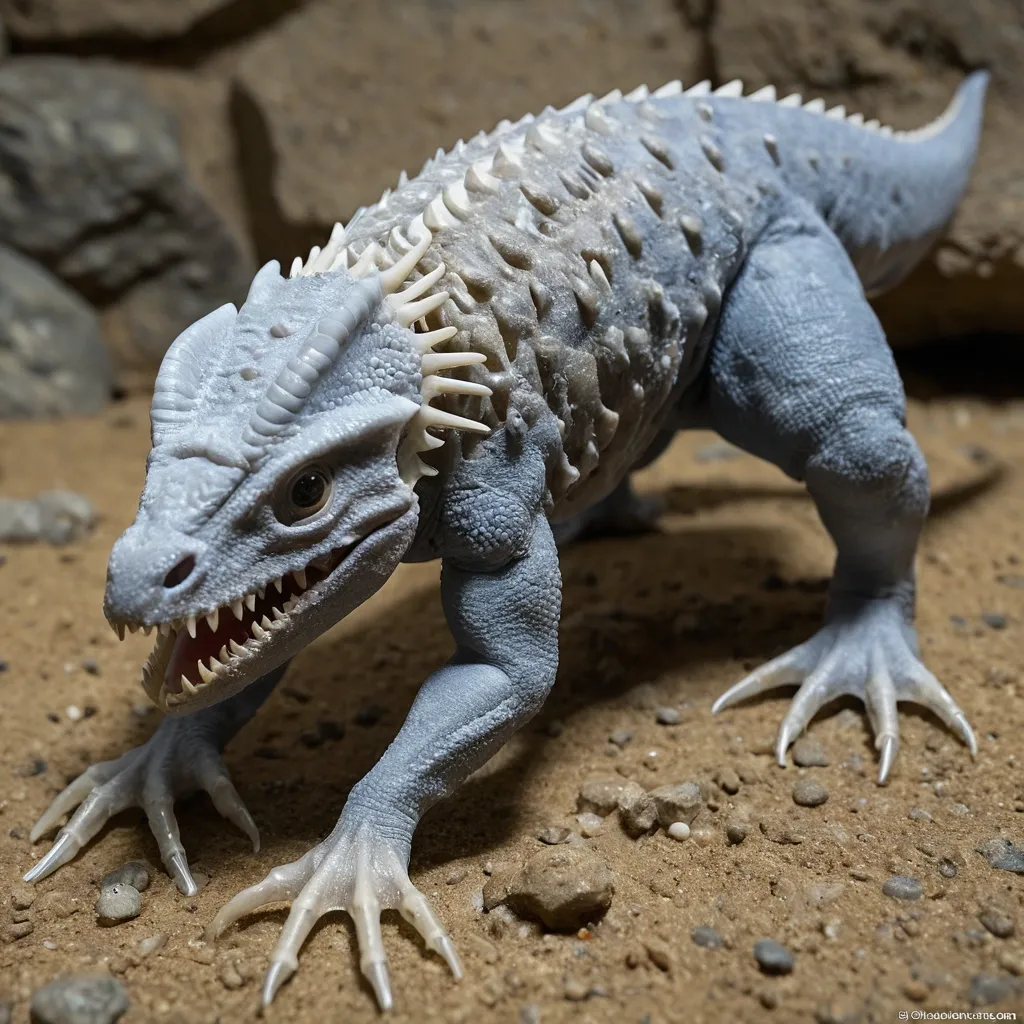
The genome of Tyrannosaurus rex , Triceratops and Giganotosaurus was used as the base genome for the hybrid. Including the shape of the head in some parts from Triceratops. Utahraptor DNA was added for high levels of intelligence and the ability to make plans , decisions and pack hunting. Reduced hind legs and Ape DNA added Knuckle-walking Quadruped. Triceratops , and Scelidosaurus were added to act as a biological form of armor that absorbed most of the incoming attacks. Northern short-tailed shrew , the Inland taipan's retractable fangs and the Komodo Dragon DNA was used to form the teeth of the Indominus that were used to tear through the flesh and armor of opponents. Saurophaganax and Gigantopithecus DNA added the presence of long strong arms with slashing hook claws and the use of tools. A swipe of the hybrid's claws would take down bigger opponents. While using tools for smaller elusive prey. Cuttlefish genes were intended to help the Venenosus withstand an accelerated growth , but it also added chromatophore cells in the skin so it could change the shape , color , and texture of its skin like a cuttlefish. Opossum , Mongoose and Tardigrades DNA was added for the Venenosus to be more resistant to climate changes , harmful toxins or bacterial infections , while tardigrades also added survival of extreme conditions such as exposure to extreme temperatures , extreme pressures , air deprivation , radiation , dehydration , and starvation. They have several defense mechanisms , including: A metabolic rate that gets as low as 0.01 percent of the normal rate. Organs protected by a sugary gel called trehalose. A protein that shields their DNA from radiation harm. Synthesis of cryoprotectant in chilly temperatures to prevent the development of ice crystals.Northern short-tailed shrew , the Inland Taipan , Greater blue-ringed octopus and the Komodo Dragon's DNA also added special cavities and glands in the skull that gave her infrared vision , and highly toxic saliva. Said DNA also gave her the ability to open her mandibles and jaws as wide as a snake , specifically at around 90 degrees.Lastly , DNA from a whiptail lizard was added for reproduction purposes. ,
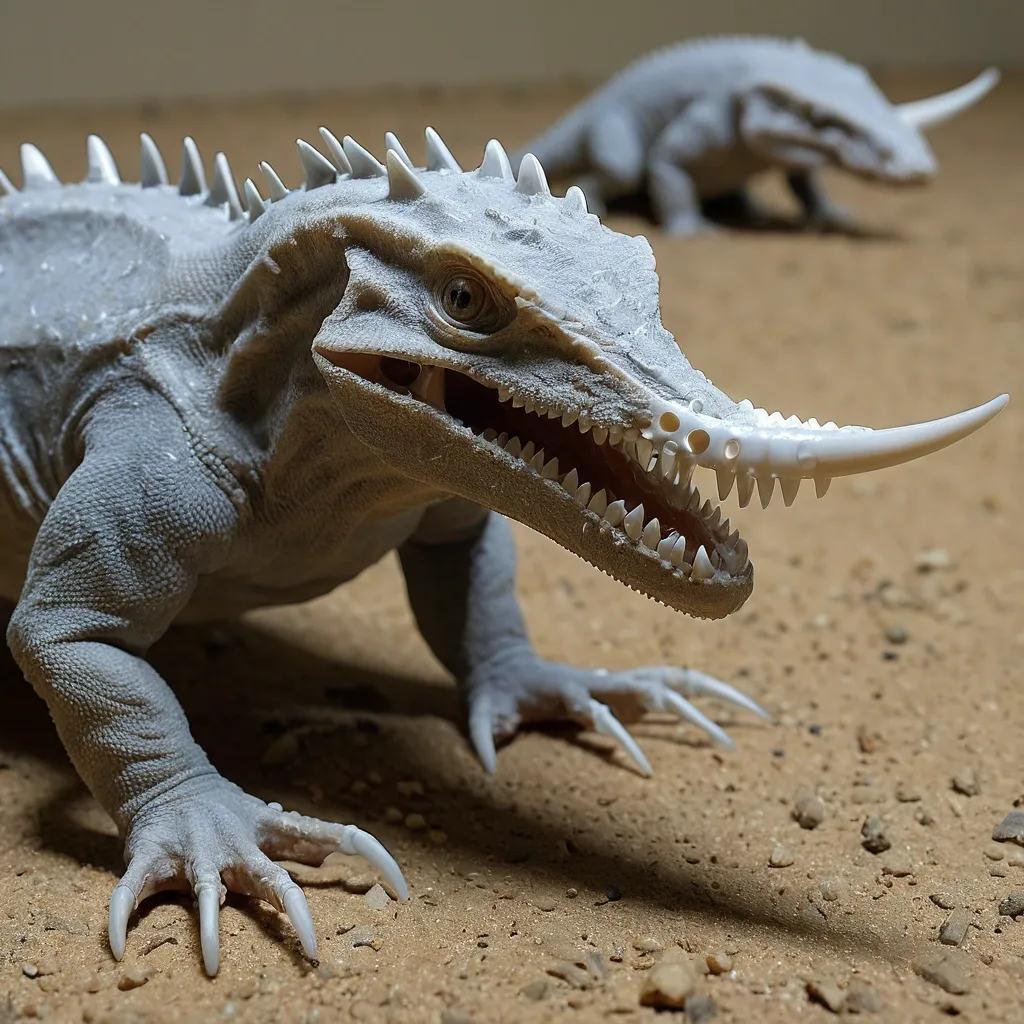
The genome of Tyrannosaurus rex , Triceratops and Giganotosaurus was used as the base genome for the hybrid. Including the shape of the head in some parts from Triceratops. Utahraptor DNA was added for high levels of intelligence and the ability to make plans , decisions and pack hunting. Reduced hind legs and Ape DNA added Knuckle-walking Quadruped. Triceratops , and Scelidosaurus were added to act as a biological form of armor that absorbed most of the incoming attacks. Northern short-tailed shrew , the Inland taipan's retractable fangs and the Komodo Dragon DNA was used to form the teeth of the Indominus that were used to tear through the flesh and armor of opponents. Saurophaganax and Gigantopithecus DNA added the presence of long strong arms with slashing hook claws and the use of tools. A swipe of the hybrid's claws would take down bigger opponents. While using tools for smaller elusive prey. Cuttlefish genes were intended to help the Venenosus withstand an accelerated growth , but it also added chromatophore cells in the skin so it could change the shape , color , and texture of its skin like a cuttlefish. Opossum , Mongoose and Tardigrades DNA was added for the Venenosus to be more resistant to climate changes , harmful toxins or bacterial infections , while tardigrades also added survival of extreme conditions such as exposure to extreme temperatures , extreme pressures , air deprivation , radiation , dehydration , and starvation. They have several defense mechanisms , including: A metabolic rate that gets as low as 0.01 percent of the normal rate. Organs protected by a sugary gel called trehalose. A protein that shields their DNA from radiation harm. Synthesis of cryoprotectant in chilly temperatures to prevent the development of ice crystals.Northern short-tailed shrew , the Inland Taipan , Greater blue-ringed octopus and the Komodo Dragon's DNA also added special cavities and glands in the skull that gave her infrared vision , and highly toxic saliva. Said DNA also gave her the ability to open her mandibles and jaws as wide as a snake , specifically at around 90 degrees.Lastly , DNA from a whiptail lizard was added for reproduction purposes. ,
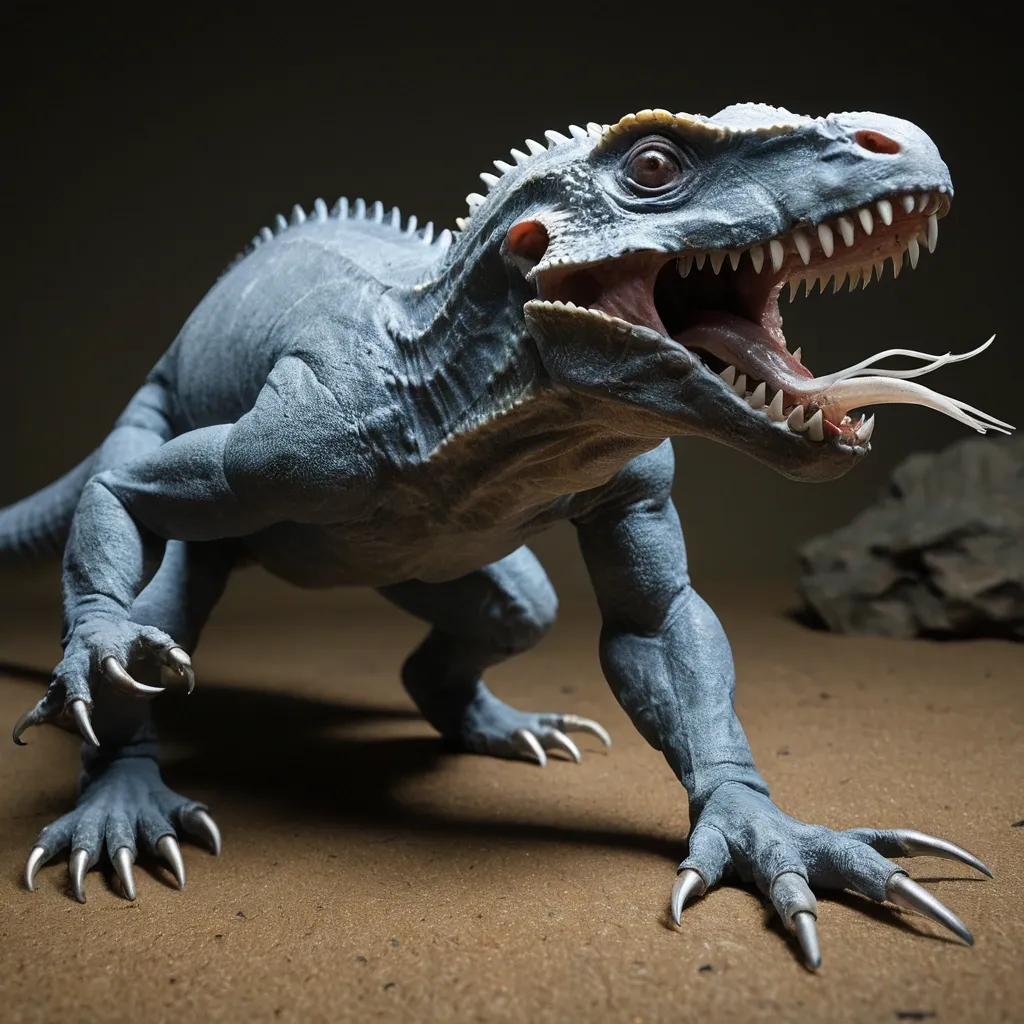
The genome of Tyrannosaurus rex , Triceratops and Giganotosaurus was used as the base genome for the hybrid. Including the shape of the head in some parts from Giganotosaurus and Triceratops. It also gave the Indominus rex an incredibly strong bite that could crush bulletproof glass. Utahraptor DNA was added for high levels of intelligence and the ability to make plans , decisions and pack hunting. Reduced hind legs and Ape DNA added Knuckle-walking Quadruped. Triceratops , and Scelidosaurus were added to act as a biological form of armor that absorbed most of the incoming attacks. Northern short-tailed shrew , the Inland taipan's retractable fangs and the Komodo Dragon DNA was used to form the teeth of the Indominus that were used to tear through the flesh and armor of opponents. Saurophaganax and Gigantopithecus DNA added the presence of long strong arms with slashing hook claws and the use of tools. A swipe of the hybrid's claws would take down bigger opponents. While using tools for smaller elusive prey. Cuttlefish genes were intended to help the Venenosus withstand an accelerated growth , but it also added chromatophore cells in the skin so it could change the shape , color , and texture of its skin like a cuttlefish. Opossum , Mongoose and Tardigrades DNA was added for the Venenosus to be more resistant to climate changes , harmful toxins or bacterial infections , while tardigrades also added survival of extreme conditions such as exposure to extreme temperatures , extreme pressures , air deprivation , radiation , dehydration , and starvation. They have several defense mechanisms , including: A metabolic rate that gets as low as 0.01 percent of the normal rate. Organs protected by a sugary gel called trehalose. A protein that shields their DNA from radiation harm. Synthesis of cryoprotectant in chilly temperatures to prevent the development of ice crystals.Northern short-tailed shrew , the Inland Taipan , Greater blue-ringed octopus and the Komodo Dragon's DNA also added special cavities and glands in the skull that gave her infrared vision , and highly toxic saliva. Said DNA also gave her the ability to open her mandibles and jaws as wide as a snake , specifically at around 90 degrees.Lastly , DNA from a whiptail lizard was added for reproduction purposes. ,
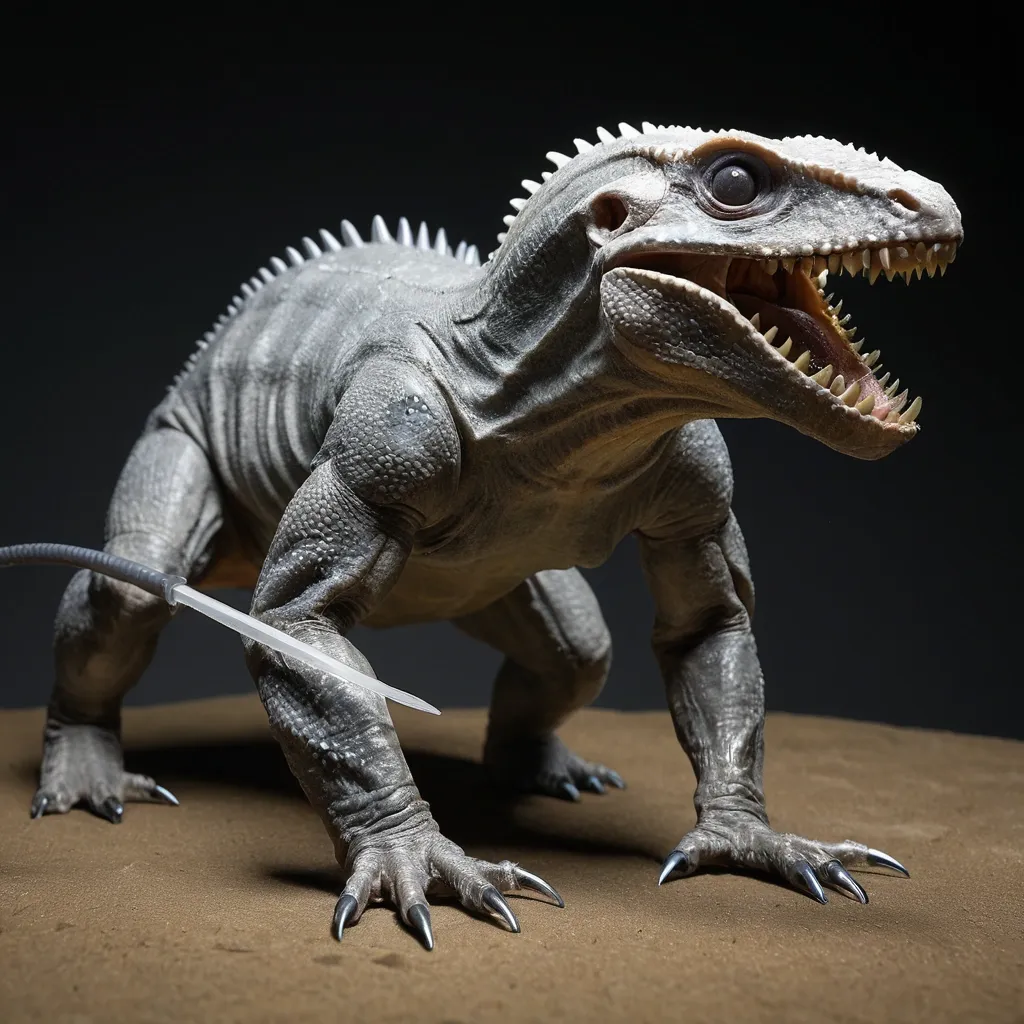
The genome of Tyrannosaurus rex , Triceratops and Giganotosaurus was used as the base genome for the hybrid. Including the shape of the head in some parts from Giganotosaurus and Triceratops. It also gave the Indominus rex an incredibly strong bite that could crush bulletproof glass. Utahraptor DNA was added for high levels of intelligence and the ability to make plans , decisions and pack hunting. Reduced hind legs and Ape DNA added Knuckle-walking Quadruped. Triceratops , and Scelidosaurus were added to act as a biological form of armor that absorbed most of the incoming attacks. Northern short-tailed shrew , the Inland taipan's retractable fangs and the Komodo Dragon DNA was used to form the teeth of the Indominus that were used to tear through the flesh and armor of opponents. Saurophaganax and Gigantopithecus DNA added the presence of long strong arms with slashing hook claws and the use of tools. A swipe of the hybrid's claws would take down bigger opponents. While using tools for smaller elusive prey. Cuttlefish genes were intended to help the Venenosus withstand an accelerated growth , but it also added chromatophore cells in the skin so it could change the shape , color , and texture of its skin like a cuttlefish. Opossum , Mongoose and Tardigrades DNA was added for the Venenosus to be more resistant to climate changes , harmful toxins or bacterial infections , while tardigrades also added survival of extreme conditions such as exposure to extreme temperatures , extreme pressures , air deprivation , radiation , dehydration , and starvation. They have several defense mechanisms , including: A metabolic rate that gets as low as 0.01 percent of the normal rate. Organs protected by a sugary gel called trehalose. A protein that shields their DNA from radiation harm. Synthesis of cryoprotectant in chilly temperatures to prevent the development of ice crystals.Northern short-tailed shrew , the Inland Taipan , Greater blue-ringed octopus and the Komodo Dragon's DNA also added special cavities and glands in the skull that gave her infrared vision , and highly toxic saliva. Said DNA also gave her the ability to open her mandibles and jaws as wide as a snake , specifically at around 90 degrees.Lastly , DNA from a whiptail lizard was added for reproduction purposes. ,
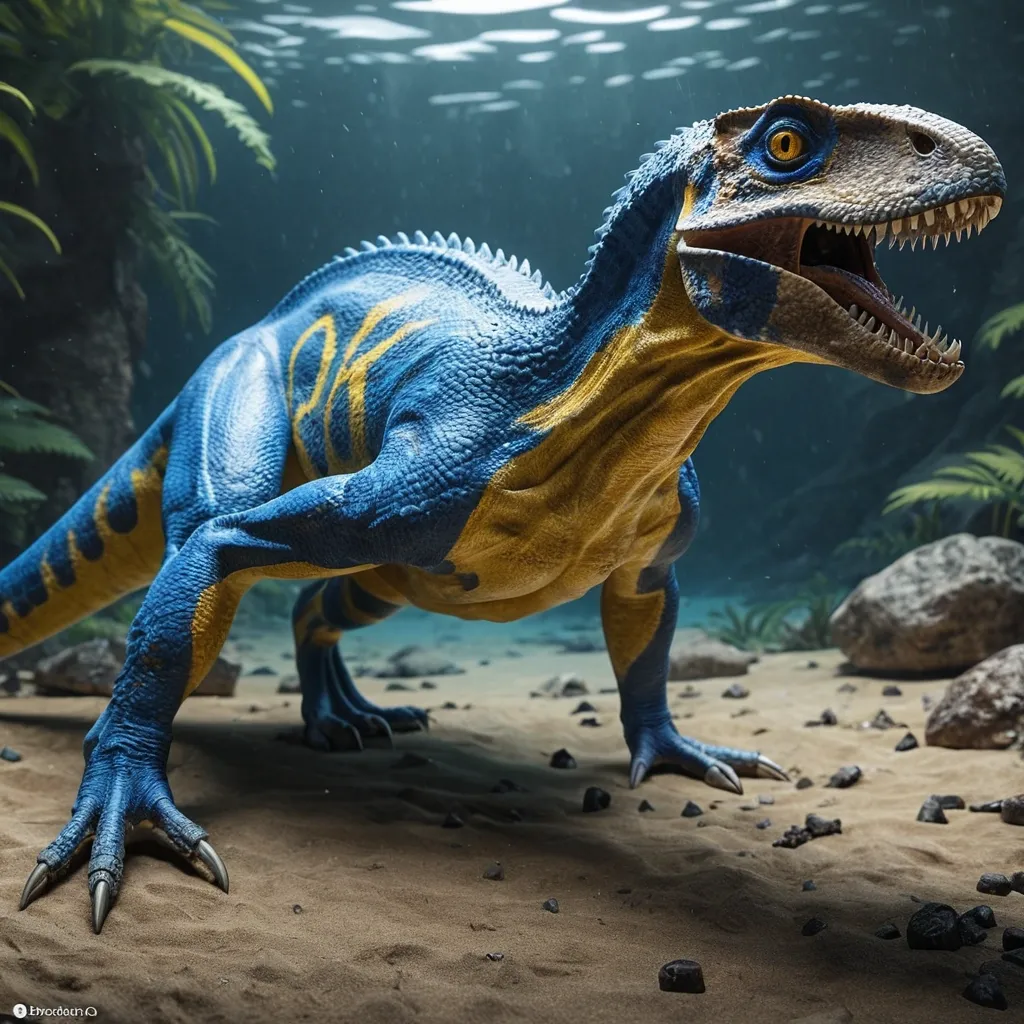
The hybrid was created by modifying the genome of a Tyrannosaurus rex , with the DNA of three other theropod species that were Utahraptor , Saurophaganax , and Giganotosaurus. Also the DNA of Quadrupes like Triceratops , and Scelidosaurus. DNA of modern animals such as Greater blue-ringed octopus , Inland Taipan , Northern Short-tailed Shrew , Komodo Dragon , Opossum , Mongoose , Gigantopithecus , Whiptail Lizard , Cuttlefish , and Tardigrades. The genome of Tyrannosaurus rex , Triceratops and Giganotosaurus was used as the base genome for the hybrid. Including the shape of the head in some parts from Giganotosaurus and Triceratops. It also gave the Indominus rex an incredibly strong bite that could crush bulletproof glass. Utahraptor DNA was added for high levels of intelligence and the ability to make plans , decisions and pack hunting. Reduced hind legs and Ape DNA added Knuckle-walking Quadruped. Triceratops , and Scelidosaurus were added to act as a biological form of armor that absorbed most of the incoming attacks. Northern short-tailed shrew , the Inland taipan's retractable fangs and the Komodo Dragon DNA was used to form the teeth of the Indominus that were used to tear through the flesh and armor of opponents. Saurophaganax and Gigantopithecus DNA added the presence of long strong arms with slashing hook claws and the use of tools. A swipe of the hybrid's claws would take down bigger opponents. While using tools for smaller elusive prey. Cuttlefish genes were intended to help the Venenosus withstand an accelerated growth , but it also added chromatophore cells in the skin so it could change the shape , color , and texture of its skin like a cuttlefish. Opossum , Mongoose and Tardigrades DNA was added for the Venenosus to be more resistant to climate changes , harmful toxins or bacterial infections , while tardigrades also added survival of extreme conditions such as exposure to extreme temperatures , extreme pressures , air deprivation , radiation , dehydration , and starvation. They have several defense mechanisms , including: A metabolic rate that gets as low as 0.01 percent of the normal rate. Organs protected by a sugary gel called trehalose. A protein that shields their DNA from radiation harm. Synthesis of cryoprotectant in chilly temperatures to prevent the development of ice crystals.Northern short-tailed shrew , the Inland Taipan , Greater blue-ringed octopus and the Komodo Dragon's DNA also added special cavities and glands in the skull that gave her infrared vision , and highly toxic saliva. Said DNA also gave her the ability to open her mandibles and jaws as wide as a snake , specifically at around 90 degrees.Lastly , DNA from a whiptail lizard was added for reproduction purposes. ,
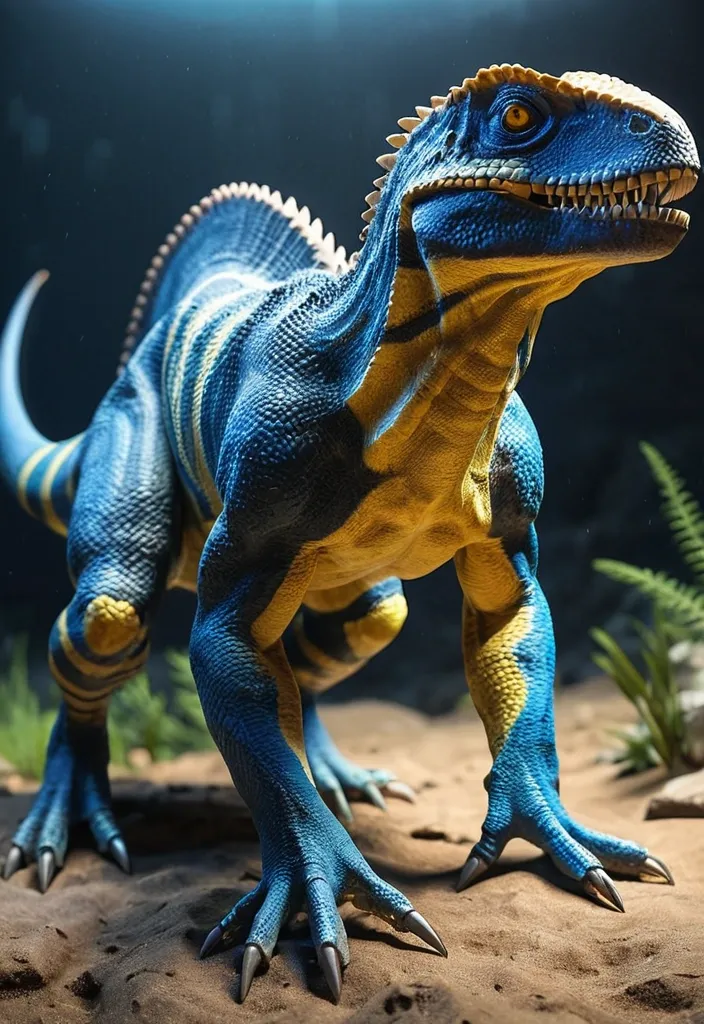
The hybrid was created by modifying the genome of a Tyrannosaurus rex , with the DNA of three other theropod species that were Utahraptor , Saurophaganax , and Giganotosaurus. Also the DNA of Quadrupes like Triceratops , and Scelidosaurus. DNA of modern animals such as Greater blue-ringed octopus , Inland Taipan , Northern Short-tailed Shrew , Komodo Dragon , Opossum , Mongoose , Gigantopithecus , Whiptail Lizard , Cuttlefish , and Tardigrades. The genome of Tyrannosaurus rex , Triceratops and Giganotosaurus was used as the base genome for the hybrid. Including the shape of the head in some parts from Giganotosaurus and Triceratops. It also gave the Indominus rex an incredibly strong bite that could crush bulletproof glass. Utahraptor DNA was added for high levels of intelligence and the ability to make plans , decisions and pack hunting. Reduced hind legs and Ape DNA added Knuckle-walking Quadruped. Triceratops , and Scelidosaurus were added to act as a biological form of armor that absorbed most of the incoming attacks. Northern short-tailed shrew , the Inland taipan's retractable fangs and the Komodo Dragon DNA was used to form the teeth of the Indominus that were used to tear through the flesh and armor of opponents. Saurophaganax and Gigantopithecus DNA added the presence of long strong arms with slashing hook claws and the use of tools. A swipe of the hybrid's claws would take down bigger opponents. While using tools for smaller elusive prey. Cuttlefish genes were intended to help the Venenosus withstand an accelerated growth , but it also added chromatophore cells in the skin so it could change the shape , color , and texture of its skin like a cuttlefish. Opossum , Mongoose and Tardigrades DNA was added for the Venenosus to be more resistant to climate changes , harmful toxins or bacterial infections , while tardigrades also added survival of extreme conditions such as exposure to extreme temperatures , extreme pressures , air deprivation , radiation , dehydration , and starvation. They have several defense mechanisms , including: A metabolic rate that gets as low as 0.01 percent of the normal rate. Organs protected by a sugary gel called trehalose. A protein that shields their DNA from radiation harm. Synthesis of cryoprotectant in chilly temperatures to prevent the development of ice crystals.Northern short-tailed shrew , the Inland Taipan , Greater blue-ringed octopus and the Komodo Dragon's DNA also added special cavities and glands in the skull that gave her infrared vision , and highly toxic saliva. Said DNA also gave her the ability to open her mandibles and jaws as wide as a snake , specifically at around 90 degrees.Lastly , DNA from a whiptail lizard was added for reproduction purposes. ,
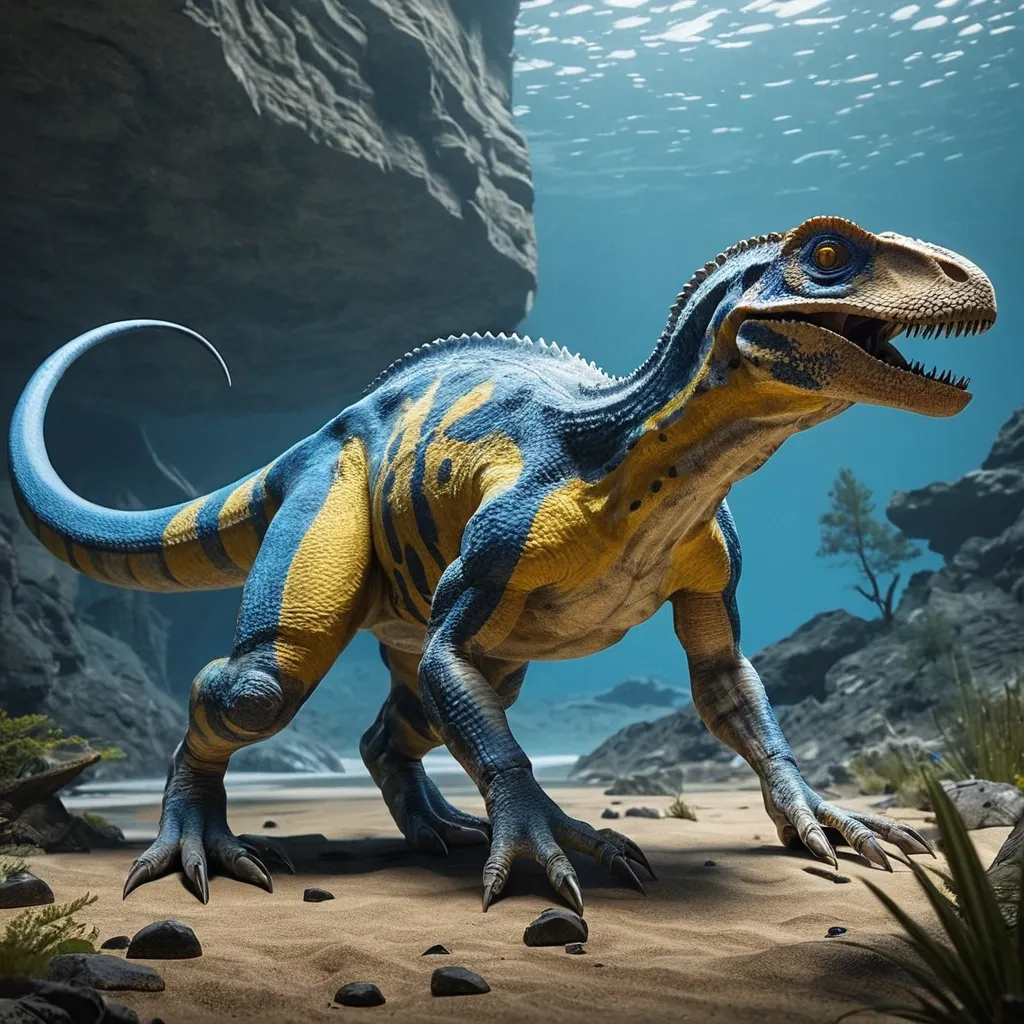
The hybrid was created by modifying the genome of a Tyrannosaurus rex , with the DNA of three other theropod species that were Utahraptor , Saurophaganax , and Giganotosaurus. Also the DNA of Quadrupes like Triceratops , and Scelidosaurus. DNA of modern animals such as Greater blue-ringed octopus , Inland Taipan , Northern Short-tailed Shrew , Komodo Dragon , Opossum , Mongoose , Gigantopithecus , Whiptail Lizard , Cuttlefish , and Tardigrades. The genome of Tyrannosaurus rex , Triceratops and Giganotosaurus was used as the base genome for the hybrid. Including the shape of the head in some parts from Giganotosaurus and Triceratops. It also gave the Indominus rex an incredibly strong bite that could crush bulletproof glass. Utahraptor DNA was added for high levels of intelligence and the ability to make plans , decisions and pack hunting. Reduced hind legs and Ape DNA added Knuckle-walking Quadruped. Triceratops , and Scelidosaurus were added to act as a biological form of armor that absorbed most of the incoming attacks. Northern short-tailed shrew , the Inland taipan's retractable fangs and the Komodo Dragon DNA was used to form the teeth of the Indominus that were used to tear through the flesh and armor of opponents. Saurophaganax and Gigantopithecus DNA added the presence of long strong arms with slashing hook claws and the use of tools. A swipe of the hybrid's claws would take down bigger opponents. While using tools for smaller elusive prey. Cuttlefish genes were intended to help the Venenosus withstand an accelerated growth , but it also added chromatophore cells in the skin so it could change the shape , color , and texture of its skin like a cuttlefish. Opossum , Mongoose and Tardigrades DNA was added for the Venenosus to be more resistant to climate changes , harmful toxins or bacterial infections , while tardigrades also added survival of extreme conditions such as exposure to extreme temperatures , extreme pressures , air deprivation , radiation , dehydration , and starvation. They have several defense mechanisms , including: A metabolic rate that gets as low as 0.01 percent of the normal rate. Organs protected by a sugary gel called trehalose. A protein that shields their DNA from radiation harm. Synthesis of cryoprotectant in chilly temperatures to prevent the development of ice crystals.Northern short-tailed shrew , the Inland Taipan , Greater blue-ringed octopus and the Komodo Dragon's DNA also added special cavities and glands in the skull that gave her infrared vision , and highly toxic saliva. Said DNA also gave her the ability to open her mandibles and jaws as wide as a snake , specifically at around 90 degrees.Lastly , DNA from a whiptail lizard was added for reproduction purposes. ,
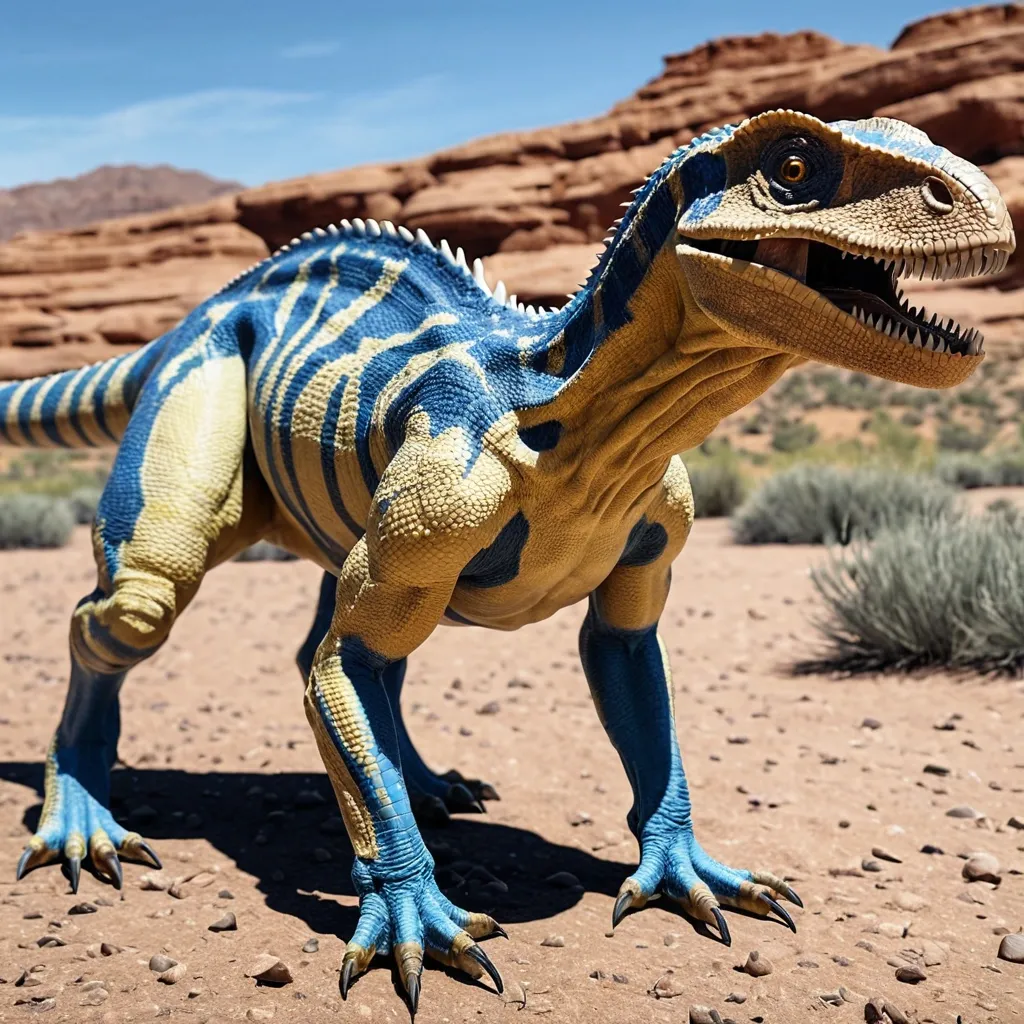
The hybrid was created by modifying the genome of a Tyrannosaurus rex , with the DNA of three other theropod species that were Utahraptor , Saurophaganax , and Giganotosaurus. Also the DNA of Quadrupes like Triceratops , and Scelidosaurus. DNA of modern animals such as Greater blue-ringed octopus , Inland Taipan , Northern Short-tailed Shrew , Komodo Dragon , Opossum , Mongoose , Gigantopithecus , Whiptail Lizard , Cuttlefish , and Tardigrades. The genome of Tyrannosaurus rex , Triceratops and Giganotosaurus was used as the base genome for the hybrid. Including the shape of the head in some parts from Giganotosaurus and Triceratops. It also gave the Indominus rex an incredibly strong bite that could crush bulletproof glass. Utahraptor DNA was added for high levels of intelligence and the ability to make plans , decisions and pack hunting. Reduced hind legs and Ape DNA added Knuckle-walking Quadruped. Triceratops , and Scelidosaurus were added to act as a biological form of armor that absorbed most of the incoming attacks. Northern short-tailed shrew , the Inland taipan's retractable fangs and the Komodo Dragon DNA was used to form the teeth of the Indominus that were used to tear through the flesh and armor of opponents. Saurophaganax and Gigantopithecus DNA added the presence of long strong arms with slashing hook claws and the use of tools. A swipe of the hybrid's claws would take down bigger opponents. While using tools for smaller elusive prey. Cuttlefish genes were intended to help the Venenosus withstand an accelerated growth , but it also added chromatophore cells in the skin so it could change the shape , color , and texture of its skin like a cuttlefish. Opossum , Mongoose and Tardigrades DNA was added for the Venenosus to be more resistant to climate changes , harmful toxins or bacterial infections , while tardigrades also added survival of extreme conditions such as exposure to extreme temperatures , extreme pressures , air deprivation , radiation , dehydration , and starvation. They have several defense mechanisms , including: A metabolic rate that gets as low as 0.01 percent of the normal rate. Organs protected by a sugary gel called trehalose. A protein that shields their DNA from radiation harm. Synthesis of cryoprotectant in chilly temperatures to prevent the development of ice crystals.Northern short-tailed shrew , the Inland Taipan , Greater blue-ringed octopus and the Komodo Dragon's DNA also added special cavities and glands in the skull that gave her infrared vision , and highly toxic saliva. Said DNA also gave her the ability to open her mandibles and jaws as wide as a snake , specifically at around 90 degrees.Lastly , DNA from a whiptail lizard was added for reproduction purposes. ,
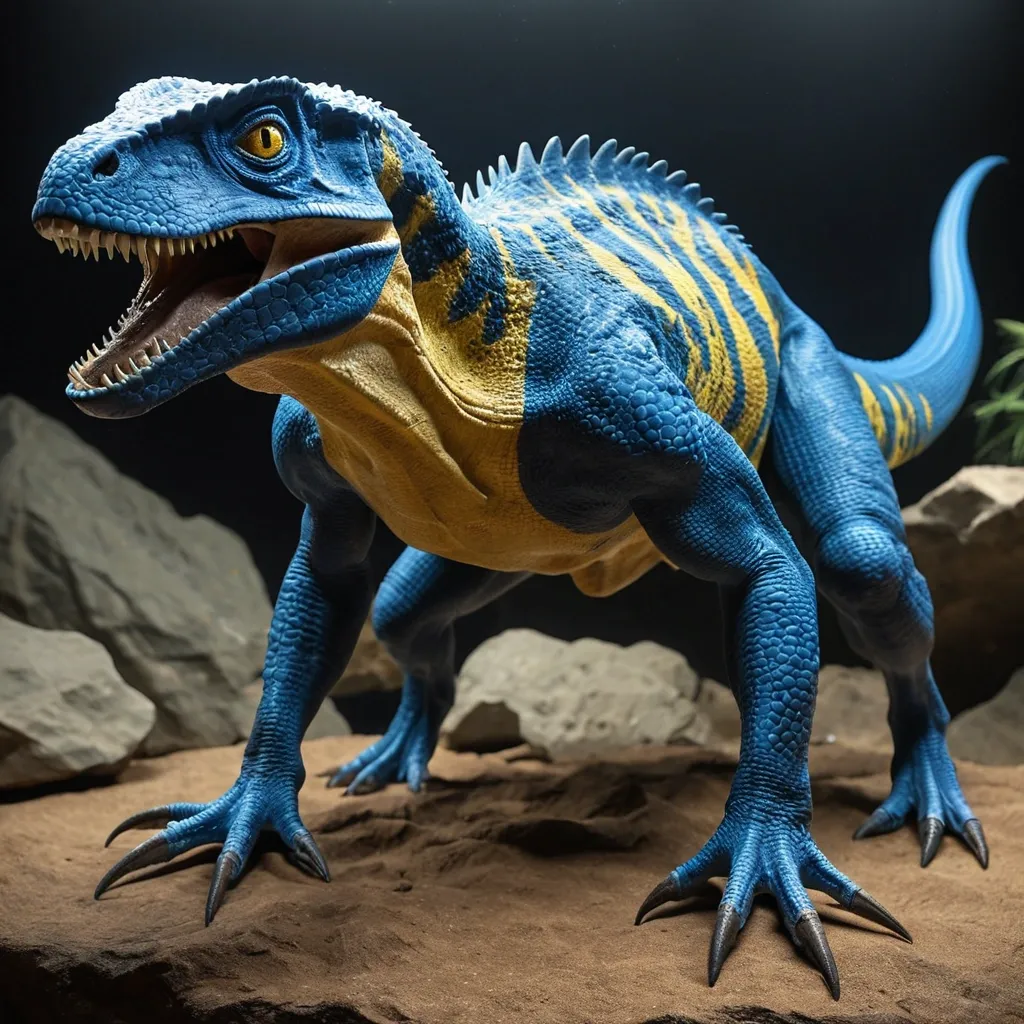
The hybrid was created by modifying the genome of a Tyrannosaurus rex , with the DNA of three other theropod species that were Utahraptor , Saurophaganax , and Giganotosaurus. Also the DNA of Quadrupes like Triceratops , and Scelidosaurus. DNA of modern animals such as Greater blue-ringed octopus , Inland Taipan , Northern Short-tailed Shrew , Komodo Dragon , Opossum , Mongoose , Ape , Whiptail Lizard , Cuttlefish , and Tardigrades. The genome of Tyrannosaurus rex , Triceratops and Giganotosaurus was used as the base genome for the hybrid. Including the shape of the head in some parts from Giganotosaurus and Triceratops. It also gave the Indominus rex an incredibly strong bite that could crush bulletproof glass. Utahraptor DNA was added for high levels of intelligence and the ability to make plans , decisions and pack hunting. Reduced hind legs and Ape DNA added Knuckle-walking Quadruped. Triceratops , and Scelidosaurus were added to act as a biological form of armor that absorbed most of the incoming attacks. Northern short-tailed shrew , the Inland taipan's retractable fangs and the Komodo Dragon DNA was used to form the teeth of the Indominus that were used to tear through the flesh and armor of opponents. Saurophaganax and Gigantopithecus DNA added the presence of long strong arms with slashing hook claws and the use of tools. A swipe of the hybrid's claws would take down bigger opponents. While using tools for smaller elusive prey. Cuttlefish genes were intended to help the Venenosus withstand an accelerated growth , but it also added chromatophore cells in the skin so it could change the shape , color , and texture of its skin like a cuttlefish. Opossum , Mongoose and Tardigrades DNA was added for the Venenosus to be more resistant to climate changes , harmful toxins or bacterial infections , while tardigrades also added survival of extreme conditions such as exposure to extreme temperatures , extreme pressures , air deprivation , radiation , dehydration , and starvation. They have several defense mechanisms , including: A metabolic rate that gets as low as 0.01 percent of the normal rate. Organs protected by a sugary gel called trehalose. A protein that shields their DNA from radiation harm. Synthesis of cryoprotectant in chilly temperatures to prevent the development of ice crystals.Northern short-tailed shrew , the Inland Taipan , Greater blue-ringed octopus and the Komodo Dragon's DNA also added special cavities and glands in the skull that gave her infrared vision , and highly toxic saliva. Said DNA also gave her the ability to open her mandibles and jaws as wide as a snake , specifically at around 90 degrees.Lastly , DNA from a whiptail lizard was added for reproduction purposes. ,
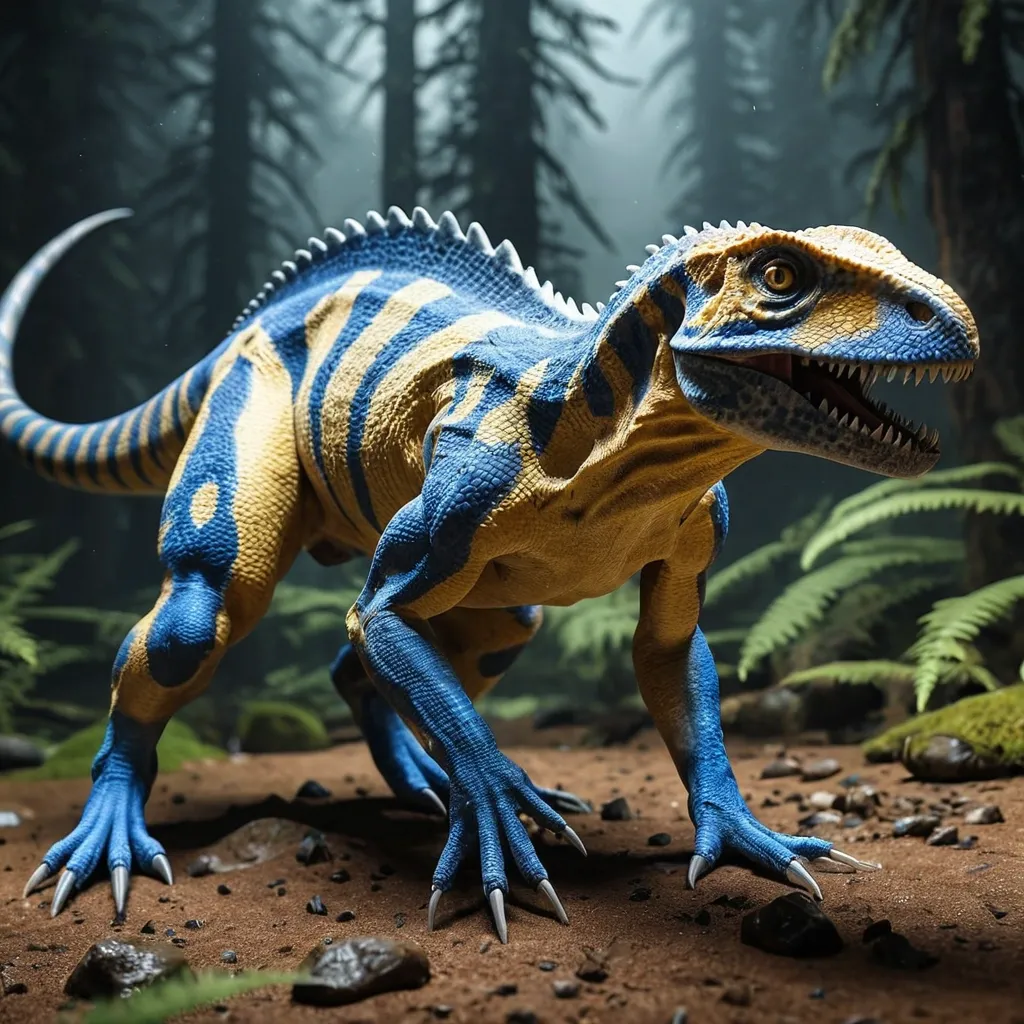
The hybrid was created by modifying the genome of a Tyrannosaurus rex , with the DNA of three other theropod species that were Utahraptor , Saurophaganax , and Giganotosaurus. Also the DNA of Quadrupes like Triceratops , and Scelidosaurus. DNA of modern animals such as Greater blue-ringed octopus , Inland Taipan , Northern Short-tailed Shrew , Komodo Dragon , Opossum , Mongoose , Ape , Whiptail Lizard , Cuttlefish , and Tardigrades. The genome of Tyrannosaurus rex , Triceratops and Giganotosaurus was used as the base genome for the hybrid. Including the shape of the head in some parts from Giganotosaurus and Triceratops. It also gave the Indominus rex an incredibly strong bite that could crush bulletproof glass. Utahraptor DNA was added for high levels of intelligence and the ability to make plans , decisions and pack hunting. Reduced hind legs and Ape DNA added Knuckle-walking Quadruped. Triceratops , and Scelidosaurus were added to act as a biological form of armor that absorbed most of the incoming attacks. Northern short-tailed shrew , the Inland taipan's retractable fangs and the Komodo Dragon DNA was used to form the teeth of the Indominus that were used to tear through the flesh and armor of opponents. Saurophaganax and Ape DNA added the presence of long strong arms with slashing hook claws and the use of tools. A swipe of the hybrid's claws would take down bigger opponents. While using tools for smaller elusive prey. Cuttlefish genes were intended to help the Venenosus withstand an accelerated growth , but it also added chromatophore cells in the skin so it could change the shape , color , and texture of its skin like a cuttlefish. Opossum , Mongoose and Tardigrades DNA was added for the Venenosus to be more resistant to climate changes , harmful toxins or bacterial infections , while tardigrades also added survival of extreme conditions such as exposure to extreme temperatures , extreme pressures , air deprivation , radiation , dehydration , and starvation. They have several defense mechanisms , including: A metabolic rate that gets as low as 0.01 percent of the normal rate. Organs protected by a sugary gel called trehalose. A protein that shields their DNA from radiation harm. Synthesis of cryoprotectant in chilly temperatures to prevent the development of ice crystals.Northern short-tailed shrew , the Inland Taipan , Greater blue-ringed octopus and the Komodo Dragon's DNA also added special cavities and glands in the skull that gave her infrared vision , and highly toxic saliva. Said DNA also gave her the ability to open her mandibles and jaws as wide as a snake , specifically at around 90 degrees.Lastly , DNA from a whiptail lizard was added for reproduction purposes. ,
